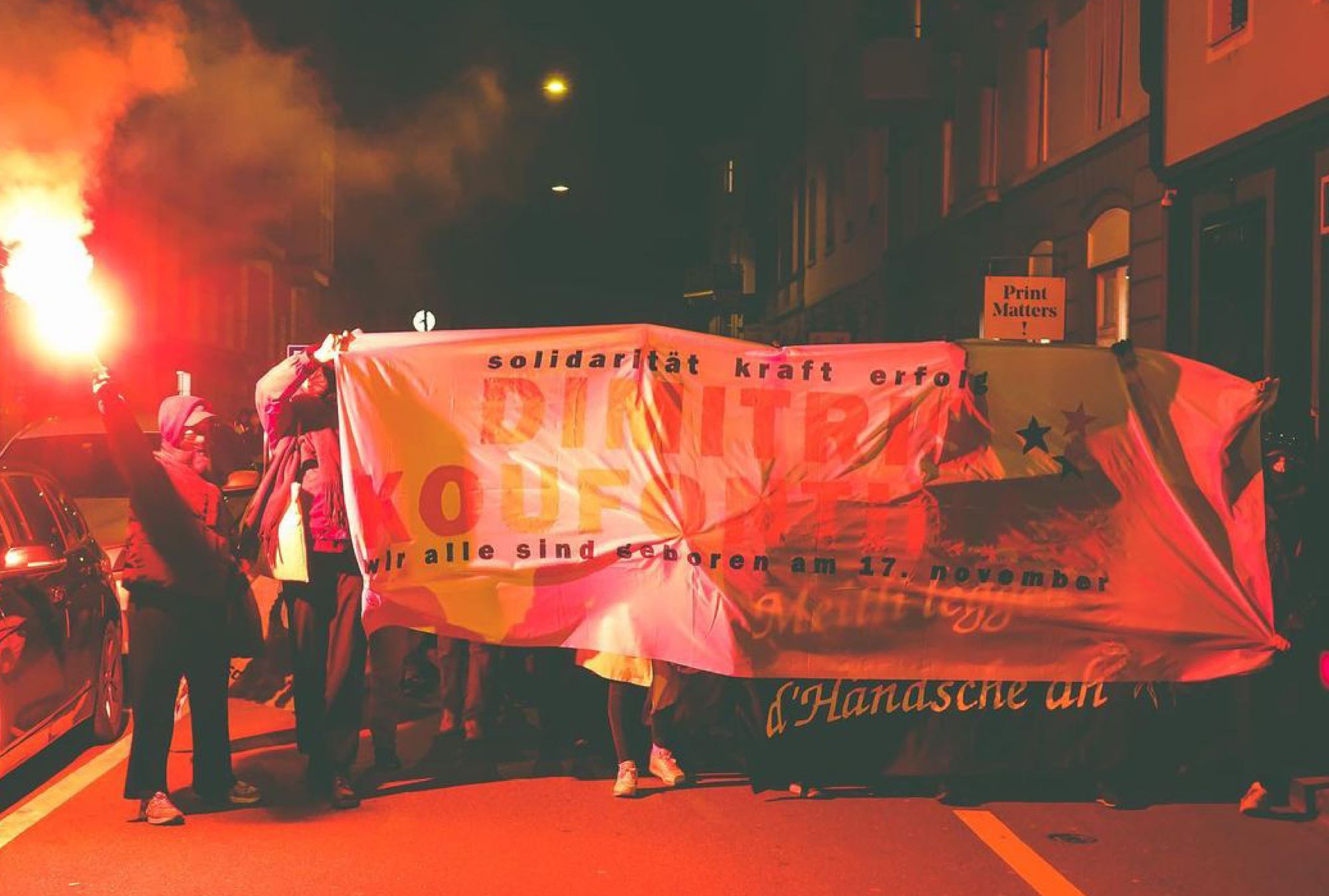
Swiss public space is hardly ever devoid of political propaganda. With its high frequency of popular votes—four yearly “voting Sundays” and sparser municipal election dates—Switzerland’s advertising spaces can never truly be rid of the visual traces of electoral and referendum votes.
In early 2021, Swiss cities and rural areas alike were crawling with billboards showing a symbol that has been central to the political propaganda of the SVP, the far right Swiss People’s Party, for nearly two decades: the veiled Muslim woman. Switzerland’s so-called direct democracy foresees a high rotation of political participation on the national, cantonal and communal level. Embedded in this are SVP’s numerous racist initiatives, which include the minaret ban in 2009, as well as multiple xenophobic referendums on immigration control and deportation. These referendums obstinately use the image of a Muslim woman wearing a burqa or niqab as the epitome of the “Islamization of Switzerland.”
This 7 March, on the eve of International Womxn’s Day, those holding Swiss citizenship rights were asked to vote on a “face covering” ban. While the amendment to the constitution is broad—the ban would apply to wearing any and all face coverings in public, including those used by hooligans—the campaign unabashedly targeted the femxle Muslim body. Its rhetoric drew brazen connections to female liberation: “Emancipation over fabric prison”, read some of the SVP’s campaign billboards, depicting two juxtaposed young women, one happy and confident in front of a light blue backdrop, her hair and face visible; and one wearing a black niqab, with subdued eyes, in front of a black background. The SVP, historically known for its misogynistic, heteropatriarchal attitudes and policies, suddenly presented itself as a party advocating for “women’s rights.” The conditions that enabled this deceptive reframing of the issue are rooted in the intimate interplay between the Swiss media, public space and direct democratic practices.
“What is our role as feminists to reconfigure a public space in which collective safety, care and inclusivity are values carried and lived in our interactions, and supported by both the built environment and social infrastructure?”
The following chronicle strives to examine those interplays and translate them into a cocktail of feminist fuel for the future.
Friday, 5 March
#dieTagesanzeigerin and #MachoMedia hashtags begin to circulate on Twitter, highlighting misogynistic attitudes in Swiss media and the lack of gendered perspectives on these issues. Parallel to that, an open letter is published, signed by 78 FLINTA (a German umbrella acronym for Womxn, Lesbians, Intersex, Non-binary, Trans and Agender) journalists employed by Tamedia, the largest Swiss media group owning 24 newspapers across the country, including the Zurich daily Tages-Anzeiger.
In the letter, the journalists denounce Tamedia’s misogynistic internal culture, and formulate six requests for an improvement of conditions. The letter declares, tiredly, that none of these are new; they were already submitted in preparation for the Feminist Strike of 2019, and still have not been addressed. Among them are an appeal for the establishment of regular “pulse checks” in the form of anonymized surveys, a promotional program for womxn’s advancement, and the shockingly simple request: “We expect our work and our views to be taken seriously. We expect to be treated with manners and respect.”
Two days later, Tamedia’s executive board makes a public statement, miserly conceding that gender-based discrimination is “not acceptable”, and that Tamedia does not tolerate any form of harassment. The questions raised in this open letter are of concern for the workforce of a prestigious Swiss company—but not only for them. As the following chronicle aims to show, Tamedia’s case is not exceptional. The misogyny of one media empire does not stand alone; it is part of a larger system in the Swiss media landscape that seeps into public opinion, pours itself into the streets, and molds how the streets are represented.
Saturday, 6 March: midday
With the loosened regulations for gatherings in public space, various feminist collectives of Zurich jointly craft 8MRZUNITE, a day of decentralized, concerted action all over the city. Described as a “PolitParcours”, or a political promenade, the program makes the presence of FLINTA folk in urban space felt throughout a crisp but sunny day, while keeping in line with public health safety measures.
The first half-hour of activities includes an info corner on climate crisis and gender, and audio contributions on the feminist urban struggle against gentrification. In the early afternoon, the municipal police begin to violently dissolve the small gatherings of the political promenade, even those groups that attract much fewer than the allowed 15 people—in the midst of areas full of crowds shopping, queuing in long lines for coffee, flea markets and fast fashion.
We look onto an already vacated Ni Una Menos Platz, a square renamed by feminist activists in 2019, the historical space of Zurich’s political mobilizations in its heavily gentrified working class area, District 4. A police officer of the so-called “dialogue team”, part of a municipal security initiative in place since 2019 to mark attenuated police presence in “spaces of urban tension”, walks up to me and my two friends to explain that the multiple activities organized by 8MRZUNITE are being treated as one single event—thus revising the way in which the recently imposed 15-person rule is interpreted. When one of my friends, a lawyer, remarks that this decision bears no legal grounds, the dialogue officer concurs, shrugging his shoulders before walking away from us. A few minutes later, seven less indifferent and fully armed policemen surround us and order us to leave the square, threatening us with criminal charges should we refuse.








Between midday and 3:30 p.m., when 8MRZUNITE had scheduled a march to conclude the afternoon of activities, dozens of people are forced to leave the area. Among them are a considerable majority of racialized bodies. They are given Rayonverbote—temporary ‘prohibition to return’ orders—or even arrested. In many instances, police harassment is directed towards young BIPOC womxn dwelling in public space, unaware of and unconnected to the political manifestations of the day. It is a foreshadowing of the political rulings on female bodies to come in the following days.
Despite its best efforts, armed with water cannons, pepper spray and physical violence, the police do not manage to stop the gathering of over 1500 FLINTA protesters, which at 5 p.m. begins to act upon their collective chants of “Demo jetzt!” or “March now!”, starting a short but energetic march. While the past years of events on and around International Womxn’s Day in Zurich have indeed experienced an inexplicable surge in police violence and repression, this year’s demonstrations exceeded all precedents. Later in the afternoon, one of the leading Swiss media outlets, Tamedia’s 20 Minuten, publishes a news item with the title “Protester bites policeman, gets arrested.”
Sunday, 7 March: morning
Too nervous about the referendum results to sleep in, while waiting for my takeout order early in the day, I leaf through the Sunday papers laid out on the bar of a neighborhood café. In an edition dedicated to “women’s topics”, NZZ am Sonntag, a newspaper owned by Tamedia’s main competitor, the NZZ-Mediengruppe, publishes a cover story about the misogyny of Italian TV, making an explicit argument about the misogyny of Italy in a broader sense.
The two reporters lament the “half-naked young women in full make-up, who frequently have undergone plastic surgery” and serve an “ornamental, decorative purpose” on a few antiquated and admittedly problematic television formats. The framing of the article in the editorial confirms the reproduction of an unsettling trope of Swiss-Italian power relations based on practices of diminishing and “othering”, when stating: “Of course we do like Italy. But their TV’s representation of women is definitely problematic.” In her work on gender innovation in Switzerland, historian Francesca Falk brilliantly illustrates the intimate relationship of Switzerland’s liberal constructed self-image in opposition to the supposedly “backward”, “immature” and “less advanced” Italian migrant; when in fact Italian migration to Switzerland actually led to an increased political consciousness amongst womxn’s—and therefore, ultimately, progress.
It goes without saying that there are plenty of things to critique about the representation of women in the Italian public sphere. Such critiques have persistently been voiced by feminist advocates for decades, for instance with respect to the treatment of femxle politicians; the surge of new-fascist movements and their calls for a heteropatriarchal return to the nuclear family; and the internal struggles of a historically militant, fragmented feminist movement in Italy. It is notable that the two reporters may echo these issues in their recently published book Hure oder Heilige. Frau sein in Italien (“Whore or Saint. Being woman in Italy”, Edition Raetia, 2021). But using pay-TV formats, already heavily criticized by Italian feminists, or assumptions about Catholicism to do so, is like talking about the plight of the Swiss woman solely through the horridly sexist image of Blick’s “Page 3 girl” (the longstanding custom of Switzerland’s leading tabloid newspaper, in place until 2017, which echoed British outlet The Sun by “introducing” a young Swiss woman to the public by printing her naked picture on page three of its daily edition).
Focusing on these phenomena is too easy, and not serious enough; by doing that, the NZZ am Sonntag article steps into the same essentialist pitfalls it denounces elsewhere, and negates the complexities of a long history of feminist mobilization. The piece is particularly enraging not only because it appears on such a politically charged day, but also because it hails from the central and powerful Swiss medium NZZ, which in recent years has led a relentless battle against intersectional feminism, the Women’s Strike of 2019 and gender sensitive language.
Sunday, 7 March: midday
It becomes clear that the prognoses and surveys of the past weeks have not painted too dark of a scenario: the niqab/burqa ban is going to pass, albeit by a smaller margin than originally envisioned. Exhaustion and anger take hold, and words are hard to find.
Repeatedly focalized as a (pseudo-)feminist matter, the past weeks had seen a surge in feminist activism against the ban. While the efforts of campaigns such as “Women against the burqa ban” led to a close call, in the end the SVP initiative goes, and anti-Muslim racism in Switzerland stays. The burqa/niqab ban initiative once again managed to normalize racist ideas as part of democratic debates, as feminist researcher Stefanie Boulila tweeted in response to the results.
Indeed, instead of dissipating, the initiative will likely disseminate even more hate. Late last year, the national councilwoman Marianne Binder, affiliated to the centrist party Mitte, submitted a postulate for the national ban of hijabs in schools and kindergartens. Another pending motion comes from SVP national councilman Jean-Luc Addor, who wants to push a hijab ban in federal offices. As the “face covering” bill’s spelled out details clearly stated, the initiative’s supposed feminist, emancipatory underpinnings were factually nonexistent: exceptions to the ban were always going to be made for face coverings that were part of manifestations of “einheimisches Brauchtum”—local traditions, for instance Basel’s carnival masks on Morgestraich, Appenzell’s ornate costumes on New Year’s Silversterklausen, or SVP’s very own propaganda mascot. The far right had thus succeeded in delineating who would be granted access to the public; in defining who is “local”, and who will never be.
Sunday, 7 March: late afternoon
The news feeds on national and local media fill up with opinion pieces and analyses of the vote on the niqab/burqa ban. However, while that dominated the media prior to and during the recent referendum, it would be fatal to limit our feminist critique of Swiss racism to this specific amendment to the constitution. Indeed, what is not said in public discourse can be just as telling.
One of the three national votes on Sunday, March 7, concerned the free trade treaty with Indonesia; a treaty that will certainly negatively affect agricultural workers on palm oil plantations, under the guise of an elitist greenwashing framework. In the canton of Zurich, where I reside, another initiative of the far-right SVP was brought to the ballot. It concerned the mentioning of nationality and migration background in police reports—a practice that had been barred only in 2017, through an effort of the Social Democratic and Green Liberal Parties. The cantonal council drafted a counter-proposal, asking to mention only nationalities, not migration backgrounds, as the “police had no time for genealogical work.” The counter-proposal passed, with a solid margin.
The debates linked to these democratic votes, rather than being seen as separate from our feminist visions for the future, should prompt the questions: What do we want our cities, our planet to look like? In what way must a feminist understanding of international relations inform our decisions on global resource networks? What is our role as feminists to reconfigure a public space in which collective safety, care and inclusivity are values carried and lived in our interactions, and supported by both the built environment and social infrastructure? Ultimately, the results of these votes demonstrated our collective need to regard feminist issues holistically, and to be more vocal in addressing foreign policy and security as pertinent concerns.
Sunday, 7 March: evening
FLINTA-led BIPOC collectives in Zurich, Bern and Basel, call for spontaneous protests to stand united against the “islamophobic, racist and patriarchal burqa/niqab ban.” The 7 p.m. gatherings are attended by several hundred people, and self-determinedly dissolved an hour or so later. They showed that public space, as it stands accessible, is where collective grief and anger are expressed. The ability to enter and exit it freely, as was demonstrated today, is more than ever a privilege to fight for.
Monday, 8 March
The shock and pain of the weekend’s events are still deeply entrenched in the minds and bodies of feminist protesters. While 20 Minuten reported that no harm had been done by the police, feminist social media channels circulate images of bruises and videos of unabashed violence. Activists and unionists start putting together a communiqué with which to address municipal authorities early in the morning. 8MRZUNITE calls for a “Maildemo”, an e-mail protest, encouraging womxn to send emails to media and state institutions about the indefensible police reactions over the weekend. In the evening, Zurich collectives call for a sit-in protest on the bridge in front of the central police station. It is swiftly broken up by police, who carry activists away by force. The protest resurfaces, an hour later, back in District 4.
“as feminists in Switzerland, concerned about state repression and the exclusionary patterns of everyday encounters in public space and within democratic infrastructure; we need to do better and we need to do more. We need to keep vigilant of what happens to and in our media landscape, in the illusionary constructs of direct democracy, on our street corners and squares.”
The events of the past days collectively materialised the message: as feminists in Switzerland, concerned about state repression and the exclusionary patterns of everyday encounters in public space and within democratic infrastructure; we need to do better and we need to do more. We need to keep vigilant of what happens to and in our media landscape, in the illusionary constructs of direct democracy, on our street corners and squares. I am certain that the observations detailed above are far from being the defining ones; they line up in a consistent trajectory of misogynistic action in the Swiss public, one that consciously and insistently decides to look outward rather than inward.
Adopting a feminist logic, these events also need not be the defining ones, as every single one of our gazes is located in a specific context, defining what we see and what we don’t see. In this instance, my lens is resolutely marked by my being the cis-gendered child of Southern European working-class immigrants, and a first generation university graduate, holding citizen rights in one of the richest cities worldwide. But this one lens does not make a full image, much like no one ingredient makes the whole cocktail. As singular subjects dedicated to the feminist cause, it is our duty to carve out the spaces of care and solidarity for many more perspectives to mix, shake and stir, in a diverse and more accessible public.
Sabrina Stallone (she/her) is a PhD researcher in social anthropology at the University of Bern, whose work examines everyday political implications of contemporary urban development. She is currently based in Zurich.














